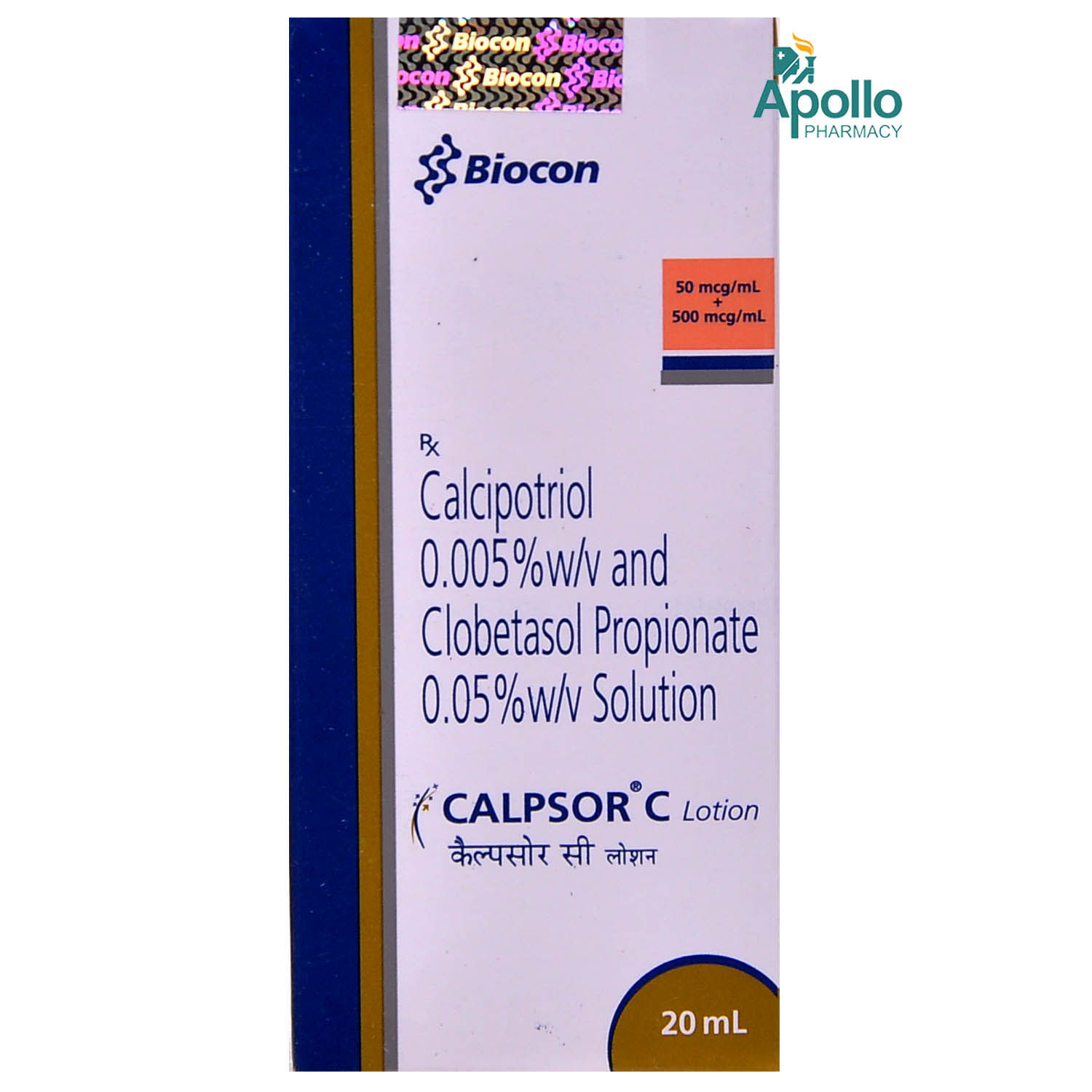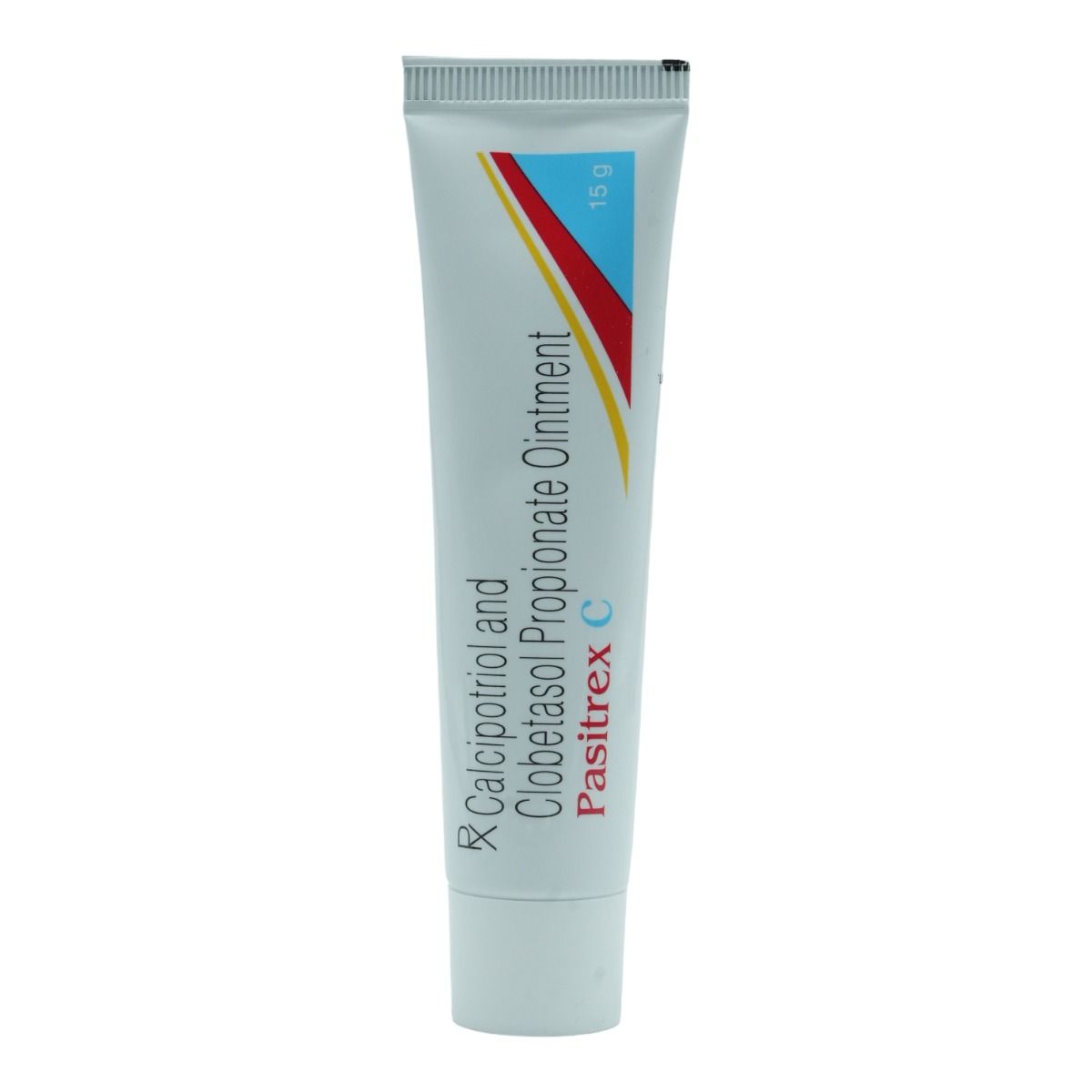Calcipotriol+clobetasol
About Calcipotriol+clobetasol
Calcipotriol+clobetasol belongs to the class of 'antipsoriatic agents', primarily used to treat psoriasis. Psoriasis is a skin disorder in which skin cells multiply and form bumpy (uneven) red patches covered with white scales. These red patches can commonly appear on the scalp, elbows, knees and lower back.
Calcipotriol+clobetasol consists of two medicines, namely: Clobetasol (corticosteroid) and Calcipotriol (synthetic Vitamin D). Clobetasol is a highly potent 'corticosteroid' with anti-inflammatory, antipruritic (relieves itching) and vasoconstrictive (narrows blood vessels) properties. It blocks the production of prostaglandins (chemical messengers), which make the skin red, swollen and itchy. On the other hand, Calcipotriol (also known as calcipotriene) is a man-made form of Vitamin D that belongs to the class of antipsoriatic agents. It helps in the inhibition of the overproduction of skin cells. It is used to treat plaque psoriasis (psoriasis vulgaris), a condition that develops thick red patches on the skin with a silver or white scaly layer.
Use this medication on the skin only as advised by the doctor. Calcipotriol+clobetasol is generally safe to use. Some may experience common side effects like itching, redness, stinging sensation, dryness and rash. These side effects do not require medical attention and gradually resolve over time. If these side effects persist longer, please consult your doctor.
Avoid contact with your eyes, nose or mouth while using Calcipotriol+clobetasol. Rinse it off with water thoroughly if you get the cream in these areas. Brief your medical history to the doctor if you are allergic to Calcipotriol+clobetasol or any of its components. Let your doctor know if you have any active skin infections before using Calcipotriol+clobetasol. Pregnant and breastfeeding women should use Calcipotriol+clobetasol only with proper consultation and caution. Calcipotriol+clobetasol is not recommended for children less than 12 years of age.
Uses of Calcipotriol+clobetasol
Medicinal Benefits
Calcipotriol+clobetasol treats psoriasis and is a combination of two medicines: namely: Clobetasol and Calcipotriol (also known as calcipotriene). Clobetasol is a corticosteroid medicine. It blocks the production of prostaglandins (chemical messengers), which make the skin red, swollen and itchy. Calcipotriol is a man-made form of Vitamin D that is an antipsoriatic agent. It inhibits the excess production of skin cells that leads to the formation of scales and patches of the skin in psoriasis. Calcipotriol+clobetasol helps treat plaque psoriasis, a most common type of psoriasis that develops thick red patches on the skin, with a silver or white scaly layer.
Directions for Use
Storage
Side Effects of Calcipotriol+clobetasol
- Itching
- Redness
- Stinging sensation
- Dryness
- Rash
Drug Warnings
Brief your medical history to the doctor, if you are allergic to Calcipotriol+clobetasol or any of its components. Therapy with topical corticosteroids like Clobetasol should be administered cautiously in patients with bacterial, fungal, viral and protozoa infections. Calcipotriol+clobetasol is not recommended for diaper rash. If you are pregnant or breastfeeding, you should use Calcipotriol+clobetasol only with proper doctor consultation and caution. Calcipotriol+clobetasol is for external use only. Avoid contact of Calcipotriol+clobetasol with eyes, nose and mouth. Rinse it off with water thoroughly if you get the cream/ointment in these areas. Do not put a bandage or a dressing on the affected area while using Calcipotriol+clobetasol unless advised by the doctor. Always wash hands before and after the application of Calcipotriol+clobetasol. Do not store Calcipotriol+clobetasol above 25°C.
Drug Interactions
Drug-Drug Interaction: Keep your doctor informed of all the medicines, including topical products you use, before starting Calcipotriol+clobetasol.
Drug-Food Interaction: No interactions found.
Drug-Disease Interaction: Before using Calcipotriol+clobetasol, let your doctor know if you have any fungal, viral, and protozoa infections
Drug-Drug Interactions Checker List:
Safety Advice

Alcohol
cautionNo interaction found of Calcipotriol+clobetasol with alcohol.

Pregnancy
cautionThere is limited data on how the Calcipotriol+clobetasol affects pregnancy. Please consult your doctor if you are planning to become pregnant or already pregnant before starting Calcipotriol+clobetasol.

Breast Feeding
cautionIt is not known if Calcipotriol+clobetasol passes into the breast milk. Please consult your doctor before using Calcipotriol+clobetasol if you are breastfeeding.

Driving
safe if prescribedThere have been no studies to investigate the effect of Calcipotriol+clobetasol on driving performance or the ability to operate machinery.

Liver
cautionLet your doctor know if you have any history of liver diseases before using Calcipotriol+clobetasol. Your doctor will weigh the benefits and potential risks before prescribing Calcipotriol+clobetasol.

Kidney
cautionLet your doctor know if you have any history of kidney diseases before using Calcipotriol+clobetasol. Your doctor will weigh the benefits and potential risks before prescribing Calcipotriol+clobetasol.

Children
cautionCalcipotriol+clobetasol is not recommended for children less than 12 years of age.
Habit Forming
Diet & Lifestyle Advise
Use mild soap while taking baths and prefer warm baths.
Always wear loose-fitting clothes to avoid further sweat and spread of the infections.
Regularly change your socks and wash your feet. Avoid shoes that make your feet sweaty and hot.
Do not walk barefoot at places like gym showers to prevent infections.
Do not scratch the affected area of skin as it can spread the infection to other body parts.
Avoid sharing towels, combs, bed sheets, shoes or socks with others.
Wash your bed sheets and towels regularly.
Avoid or limit the intake of alcohol and caffeine.
Do not scratch or pick your skin to avoid getting the affected area infected.
Manage stress, eat healthily, drink plenty of water, exercise regularly and sleep peacefully.
Special Advise
Monitor your blood sugar levels and blood pressure regularly while using Calcipotriol+clobetasol.
If you do not notice any improvement of your infection after using Calcipotriol+clobetasol for one to two weeks, please consult your doctor.
Patients Concern
Disease/Condition Glossary
Psoriasis: It is a skin disorder in which skin cells multiply and form bumpy (uneven) red patches covered with white scales. These red patches can commonly appear on the scalp, elbows, knees, and lower back. Psoriasis is a noncontagious (not spread by contact), chronic immune condition with no cure. It can be mild, moderate and severe based on the patches coverage on the skin. People with 80-90% suffering from psoriasis have plaque psoriasis. Psoriasis can be pustular, guttate, inverse and erythrodermic. Pustular psoriasis mainly covers palms of the hands and soles of the feet. Guttate psoriasis usually starts in childhood or young age and affects the torso and limbs. Inverse psoriasis forms bright red lesions in armpits, groin and under the breasts. Erythrodermic psoriasis is triggered by sunburn, infections and certain medications that cause redness and shedding of the skin.
FAQs
Calcipotriol+clobetasol is used to treat Psoriasis, a skin disorder in which skin cells multiply and form bumpy (uneven) red patches covered with white scales.
Calcipotriol+clobetasol is composed of Clobetasol, a steroid and Calcipotriol, an antipsoriatic agent. These two medicines help in treating the red bumpy patches and relieve itchiness and redness at psoriasis-affected areas.
Calcipotriol+clobetasol can make your skin more sensitive to the harmful effects of the sunlight. Hence it is advised to use sunscreen and wear protective clothing while using Calcipotriol+clobetasol. It is also recommended to avoid tanning booths and sunlamps.
Calcipotriol+clobetasol is used only for the treatment of psoriasis. It is not recommended for diaper rash. Your baby's paediatrician will suggest other medicines for the treatment of diaper rash.
Do not stop using Calcipotriol+clobetasol even if you feel better until the doctor's advised course is finished. Your symptoms may improve, but the disease may not be cured completely.
Calcipotriol+clobetasol is for topical (for skin use) application only. Avoid Calcipotriol+clobetasol contact with eyes, nose and mouth. Do not put a bandage or a dressing on the affected area while using Calcipotriol+clobetasol unless advised by the doctor.
It is essential to consult with your dermatologist or healthcare practitioner for personalized guidance. They will evaluate your situation and recommend the best treatment approach, including how long to use the lotion.
Calcipotriol+clobetasol is only for external use. Take a small amount of Calcipotriol+clobetasol on the fingertip and apply it as a thin layer on the clean and dry affected area as your doctor prescribes. Avoid contact with the Calcipotriol+clobetasol with the nose or eyes. In case of accidental contact with these areas, rinse with water thoroughly. Wash your hands before and after using Calcipotriol+clobetasol if your hands are not the affected area to prevent the spread of infection.
Common side effects of Calcipotriol+clobetasol may include itching, redness, stinging sensation, dryness, and rash. These side effects do not require medical attention and gradually resolve over time. If they persist longer, please consult your doctor.
The frequency of application will depend on your specific condition and your doctor's instructions. Generally, it's applied once or twice daily to the affected areas.
Using Calcipotriol+clobetasol on your face is generally not recommended without consulting your doctor. The skin on your face is more sensitive, and there may be a higher risk of side effects.
If you are pregnant or breastfeeding, it's crucial to consult with your doctor before using Calcipotriol+clobetasol. They can assess the potential risks and benefits and provide appropriate guidance.
Yes, prolonged use of Calcipotriol+clobetasol may cause skin thinning. It's important to use it as directed and avoid excessive application.
The time it takes for Calcipotriol+clobetasol to improve psoriasis symptoms varies from person to person. Some people may notice improvements within a few weeks, while others may take longer.
While Calcipotriol+clobetasol itself doesn't increase sun sensitivity, protecting your skin from excessive sunlight exposure is still a good idea, especially if you have psoriasis.
Calcipotriol+clobetasol is generally not recommended for children under the age of 12. If your child has psoriasis, consult with a paediatrician for appropriate treatment options.









